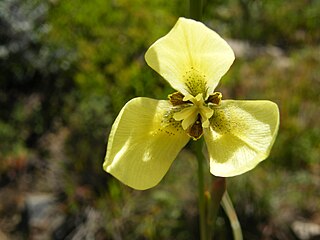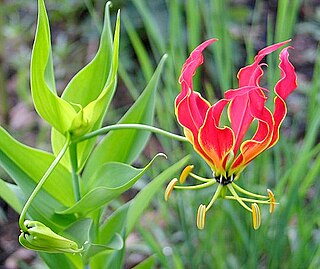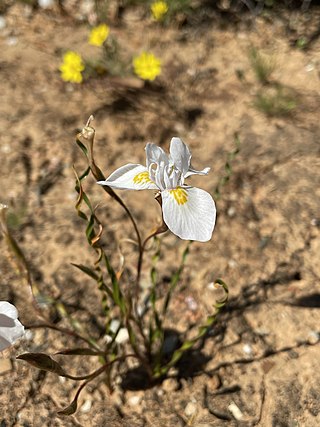
Metrosideros is a genus of approximately 60 trees, shrubs, and vines mostly found in the Pacific region in the family Myrtaceae. Most of the tree forms are small, but some are exceptionally large, the New Zealand species in particular. The name derives from the Ancient Greek metra or "heartwood" and sideron or "iron". Perhaps the best-known species are the pōhutukawa, northern and southern rātā of New Zealand, and ʻōhiʻa lehua, from the Hawaiian Islands.

Reseda, also known as the mignonette, is a genus of fragrant herbaceous plants native to Europe, southwest Asia and North Africa, from the Canary Islands and Iberia east to northwest India. The genus includes herbaceous annual, biennial and perennial species 40–130 cm tall. The leaves form a basal rosette at ground level, and then spirally arranged up the stem; they can be entire, toothed or pinnate, and range from 1–15 cm long. The flowers are produced in a slender spike, each flower small, white, yellow, orange, or green, with four to six petals. The fruit is a small dry capsule containing several seeds.

Darwinia, sometimes commonly known as mountain bells or simply bells, is a genus of about 70 species of evergreen shrubs in the family Myrtaceae, endemic to southeastern and southwestern Australia. The majority are native to southern Western Australia, but a few species occur in South Australia, New South Wales and Victoria. The genus was named in honour of Erasmus Darwin, grandfather of Charles Darwin by Edward Rudge in 1816. Most darwinias grow to a height of between 0.2 and 3 m, and many are prostrate shrubs. Most have small, simple leaves and the flowers are often grouped together, each flower with five red, white or greenish petals and ten stamens. In many species, the flowers are surrounded by large, colourful bracts, giving rise to their common names.

Dietes is a genus of rhizomatous plants of the family Iridaceae, first described as a genus in 1866. Common names include wood iris, fortnight lily, African iris, Japanese iris and butterfly iris, each of which may be used differently in different regions for one or more of the six species within the genus.

Diplarrena is a genus of flowering plants in the family Iridaceae. The two species are endemic to Australia. The name is from Greek diploos ("double") and arren ("male"); plants in the genus have only two functional stamens, while all other Iridaceae have three. The name is often misspelled Diplarrhena, an error that began with George Bentham's Flora Australiensis in 1873.

Banksia spinulosa, the hairpin banksia, is a species of woody shrub, of the genus Banksia in the family Proteaceae, native to eastern Australia. Widely distributed, it is found as an understorey plant in open dry forest or heathland from Victoria to northern Queensland, generally on sandstone though sometimes also clay soils. It generally grows as a small shrub to 2 metres (7 ft) in height, though can be a straggly tree to 6 metres (20 ft). It has long narrow leaves with inflorescences which can vary considerably in coloration; while the spikes are gold or less commonly yellowish, the emergent styles may be a wide range of colours – from black, purple, red, orange or yellow.

Dietes iridioides, commonly named African iris, fortnight lily, and morea iris, is a species of plant in the family Iridaceae that is native to Southern Africa.

Lantana camara is a species of flowering plant within the verbena family (Verbenaceae), native to the American tropics. It is a very adaptable species, which can inhabit a wide variety of ecosystems; once it has been introduced into a habitat it spreads rapidly; between 45ºN and 45ºS and more than 1,400 metres in altitude.

Moraea, the Cape tulips, is a genus of plants in the family Iridaceae, first described as a genus in 1758. The group is widespread across Africa, the Mediterranean, and central and southwestern Asia. The genus name is a tribute to the English botanist Robert More.

The West Coast National Park lies 88 km (55 mi) north of Cape Town in the Western Cape province of South Africa. The park is found inside of the Cape West Coast Biosphere Reserve, part of the UNESCO Man and the Biosphere Programme. It is bordered by the Atlantic Ocean on the west and the R27 coastal road, and runs from the town of Yzerfontein in the south, up to the Langebaan Lagoon. The park is particularly well known for its bird life and for the spring flowers which occur in the months from August to September, especially in the Postberg flower reserve section of the park. The park, with the islands in Saldanha Bay, has been identified by BirdLife International as an Important Bird Area. The park was proclaimed in 1985, and is 36,259.8 hectares (140.000 sq mi) in size.

Moraea bellendenii is a species of plant in genus Moraea that was named after John Bellenden, the English botanist.

Moraea bituminosa is a species of the genus Moraea in family Iridaceae.

Peninsula Shale Renosterveld (PSR) is a unique vegetation type that is found only on the slopes of Signal Hill and Devil's Peak in Cape Town, South Africa. It is critically endangered and exists nowhere else.

Moraea aristata is a species of flowering plant in the family Iridaceae. It is referred to by the common names blue-eyed uintjie or Blouooguintjie in Afrikaans.It is endemic to the city of Cape Town and is considered to be critically endangered.

Swartland Shale Renosterveld is a critically endangered vegetation type of the Western Cape, South Africa.

Abutilon pitcairnense, the yellow fatu or yellow fautu, is a critically endangered perennial plant that is native to Pitcairn Island. It was once considered extinct, until a single plant was discovered on the island in 2003. At that time, cuttings and seed were used to propagate several plants at a nursery on the island and botanical gardens in Ireland and England. The last wild surviving plant died in a landslide in 2005, making the plant extinct in the wild.

Gloriosa superba is a species of flowering plant in the family Colchicaceae. Common names include flame lily, climbing lily, creeping lily, glory lily, gloriosa lily, tiger claw, agnishikha and fire lily.

Darwinia collina, commonly known as the yellow mountain bell, is a plant in the myrtle family Myrtaceae. It grows as an erect shrub 0.3–1.2 metres (1–4 ft) high with crowded elliptical leaves and bright yellow flower-like inflorescences. It is endemic to a few small areas in the Stirling Range National Park, Western Australia and as a result is classified as an endangered species.

Moraea polystachya is a species of plant in the family Iridaceae native to southern Africa.

Moraea serpentina is a flowering plant species in the genus Moraea. It is endemic to the Northern Cape and Western Cape of South Africa.
Terry Trinder Smith & Mary Matham Kidd and Fay Anderson: Wild Flowers of the Table Mountain National Park: South African Wild Flower Guide 12 Botanical Society of South Africa 2006. ISBN 1-874999-60-0




















